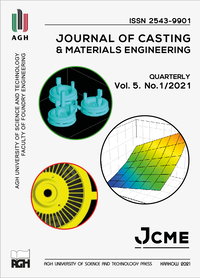Optimization of a gating system by means of simulation software to eliminate cold shut defects in casting
DOI:
https://doi.org/10.7494/jcme.2021.5.1.1Abstract
The current trend in foundries is to achieve the production of high quality and competitive cast components. The innovation and optimization of current processes is a necessary element to achieve this goal. With the help of numerical simulations, it is possible to replace financially demanding and time-consuming experiments in real conditions with simulations that can reliably represent foundry process using computer technology. By a detailed analysis of the simulation results, we can predict various risks that could negatively affect the production process. This article monitors the influence of changes in the design of the gating system on the surface quality of a clutch wheel casting made of ductile iron, in the production of which two models of the gating system for casting were constructed in CAD software. Verification of gating systems was performed using the simulation software NovaFlow & Solid. The aim of the design change of the gating system is to reduce the amount of liquid metal used per casting, which can have a significant economic impact on industrial production. For this purpose, several simulations of the gating system of the casting were performed, while 2 which are the most representative for the mentioned problem were selected for the needs of the article. The main task of the simulation was to set the cellular network and conditions as close as possible to the reality of casting and the subsequent design and modification of the gating system.
Downloads
References
Olofsson J., Salomonsson K. & Svensson I.L. (2015). Modelling and simulations of ductile iron solidification-induced variations in mechanical behaviour on component and microstructural level. IOP Conference Series: Materials Science and Engineering, 84, 12026. Doi: https://doi.org/10.1088/1757-899X/84/1/012026.
Sulamet-Ariobimo R.D., Soedarsono J.W. & Suharno B. (2015). Cooling Rate Analysis of Thin Wall Ductile Iron Using Microstructure Examination and Computer Simulation. Applied Mechanical and Materials, 752–753, 845–850. Doi: https://doi.org/10.4028/www.scientific.net/AMM.752-753.845.
Bhatt H., Barot R., Bhatt K., Beravala H. & Shah J. (2014). Design Optimization of Feeding System and Solidification Simulation for Cast Iron. In: Procedia Technology. 2nd International Conference on Innovations in Automation and Mechatronics Engineering, ICIAME 2014, Gujarat, India, 7–8 March, 14, 357–364. Retrieved from https://www.sciencedirect.com/science/article/pii/S22120-
-17314000826.
Futáš P., Pribulová A., Fedorko G., Molnár V., Junáková A. & Laskovský V. (2019). Failure analysis of railway brake disc with the use of casting process simulation. Engineerign Failure Analysis, 95, 226–238. Doi: https://doi.org/10.1016/j.engfailanal.2018.09.005.
Jolly M. (2002). Casting simulation – How well do reality and virtual casting match? State of the art review. International Journal of Cast Metals Research, 14(5), 303–313. Doi: https://doi.org/10.1080/13640461.2002.11819448.
Novacast (2018). Release of NovaFlow&Solid 6.4. Retrieved from
https://www.novacast.se/news/release-of-novaflowsolid-6-4/(accessed 1.02.2021).
MAGMASOFT® 5.4 – Autonomous Engineering. Retrieved from https://www.magmasoft.co.in/export/shared/.galleries/pdfs_pub-
lications/2018_pm_en_magmasoft_rel_5_4.pdf (accessed 5.02.2021).
Zexuan W., Tao H., Yong Y. & Yan L. (2015). Application and development of numerical simulation technology in Casting. International Journal of Research in Engineering and Science (IJRES), 3(2), 23–28. Retrieved from https://www.academia.edu/12390402/Application_and_development_of_numerical_simulation_technology_in_Casting?sm=b (accessed 26.02.2021).
Ha J., Cleary P., Alguine V. & Nguyen T. (1999). Simulation of die filling in gravity die casting using SPH and MAGMAsoft. In: Second International Conference on CFD in the Minerals and Proc-
ess Industries, CSIRO, Melbourne, Australia, 6–8 December, 423–428. Retrieved from http://www.cfd.com.au/cfd_conf99/papers/045HA.PDF (accessed 5.02.2021).
Downloads
Published
Issue
Section
License
Copyright (c) 2021 Vladimír Šabík, Peter Futáš, Alena Pribulová, Petra Delimanová

This work is licensed under a Creative Commons Attribution 4.0 International License.


